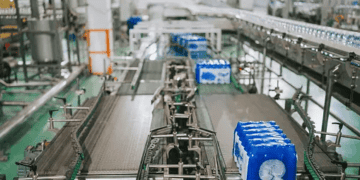While product packaging may not always be top of mind for consumers, the fast-moving consumer goods (FMCG) packaging industry has witnessed significant changes in recent years. With growing environmental awareness among consumers, companies are adapting to align with sustainability trends. In this article, we explore three recent sustainability trends in FMCG packaging and their implications for the supply chain.
Trend 1: Innovation using recycled materials
In response to environmental concerns, businesses are embracing more sustainable packaging solutions. Technological advancements enable manufacturers to reduce reliance on virgin plastics and innovate with recycled materials. Companies like Danone are striving for a circular economy of packaging, where 100% of packaging is reusable, recyclable, or compostable. Bacardi has introduced a 100% biodegradable plant-based liquor bottle, and Coca-Cola has experimented with paper-based bottles.
Moreover, additive manufacturing (3D printing) is being considered for packaging. It not only reduces waste by extending shelf life but also serves as a sustainable means of prototyping new packaging ideas. While such innovations hold promise, there are trade-offs, including cost, product protection, and quality.
From a logistics perspective, advanced and lighter packaging can lead to positive environmental impacts by optimizing payloads, enhancing fuel efficiency, and improving handling and storage efficiency.
Trend 2: Smart packaging on the rise
The growth of smart packaging is another notable trend. Smart packaging allows the monitoring of perishable products and medications during transit, reducing the risk of waste. New developments in this field include the use of ‘desiccant-based triboelectric nanogenerators’ (D-TENG) that monitor temperature, moisture, and pathogens in perishable products in transit. This self-powered system can significantly reduce spoilage, cut costs, and ensure food safety.
Smart packaging also has the potential to reduce energy consumption by improving supply chain visibility, minimizing over or understocking, and offering temperature-controlled options.
Trend 3: ‘Shrinkflation’
‘Shrinkflation’ involves reducing the physical size of products while maintaining their price levels. Companies often resort to shrinkflation due to rising costs. While this practice can lead to customer dissatisfaction, it offers various logistics benefits, including cost savings in manufacturing, packaging, transportation, and warehousing.
However, adjusting packaging sizes in FMCG is not without challenges, and the potential reputational damage must be considered carefully. Companies must weigh these factors against the logistics and cost benefits before implementing shrinkflation.
In conclusion, FMCG packaging is undergoing a transformation driven by sustainability concerns. Businesses are exploring innovative materials, smart packaging solutions, and ‘shrinkflation’ strategies to meet environmental goals while optimizing their supply chains for efficiency and cost savings. These trends underscore the evolving landscape of FMCG packaging and its impact on the broader supply chain.
Your go-to for supply chain report news updates: The Supply Chain Report. For international trade tools, see ADAMftd.com.
#FMCGPackaging #SustainablePackaging #EcoFriendlySolutions #RecycledMaterials #CircularEconomy #SmartPackaging #PackagingInnovation #BiodegradablePackaging #AdditiveManufacturing #3DPrinting #SupplyChainOptimization #Shrinkflation #EnvironmentalImpact #PackagingTrends #LogisticsEfficiency #FoodSafety #SustainabilityTrends #GreenPackaging #PackagingRevolution #FMCGLogistics #EcoInnovation #PackagingSolutions #SupplyChainEfficiency

















